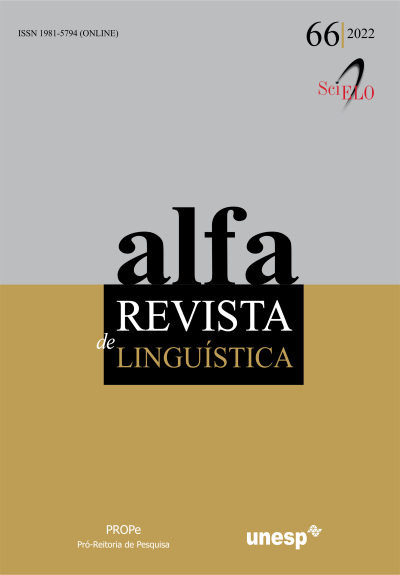Sobre a sintaxe de construções ought-to-be com e sem addressee específico
DOI:
https://doi.org/10.1590/1981-5794-e14270Palavras-chave:
deôntico ought-to-be, modalidade deôntica, relação falante-interlocutor, categoria cPResumo
O presente artigo tem como foco o deôntico ought-to-be, analisado a partir dos conceitos de obrigação discutidos em Castañeda (1970), Feldman (1986) e Hacquard (2006, 2010). A partir de testes de co-ocorrência de um modal ought-to-be com elementos que ocorrem na camada CP – em particular, com a expressão-wh por que e com elementos adverbiais –, constatamos que o ought-to-be é interpretado entre as posições altas de IntP e ModP. Mostramos também que um ought-to-be pode figurar em construções com ou sem addressee específico e que essa diferença se reflete na sintaxe. Nossa proposta é estender a análise de Portner, Pak e Zanuttini (2019), desenvolvida para partículas de estilo de fala do coreano, para o deôntico ought-to-be, postulando que esse deôntico, quando usado com um addressee específico, integra uma estrutura em que a categoria cP é projetada, o que permite que traços que expressam a relação falante-interlocutor, tais como o traço de status, sejam checados. Consequentemente, esse modal é restrito ao domínio matriz. Por outro lado, quando ele ocorre em uma sentença sem addressee específico, ele integra uma estrutura sem a projeção de cP, uma vez que ele não remete à relação falante-interlocutor. Nesse caso, o modal aparece em domínios matrizes e encaixados.
Downloads
Downloads
Publicado
Como Citar
Edição
Seção
Licença
Copyright (c) 2022 ALFA: Revista de Linguística

Este trabalho está licenciado sob uma licença Creative Commons Attribution 4.0 International License.
Os manuscritos aceitos e publicados são de propriedade da Alfa: Revista de Linguística. É vedada a submissão integral ou parcial do manuscrito a qualquer outro periódico. A responsabilidade do conteúdo dos artigos é exclusiva dos autores. É vedada a tradução para outro idioma sem a autorização escrita do Editor ouvida a Comissão Editorial.

